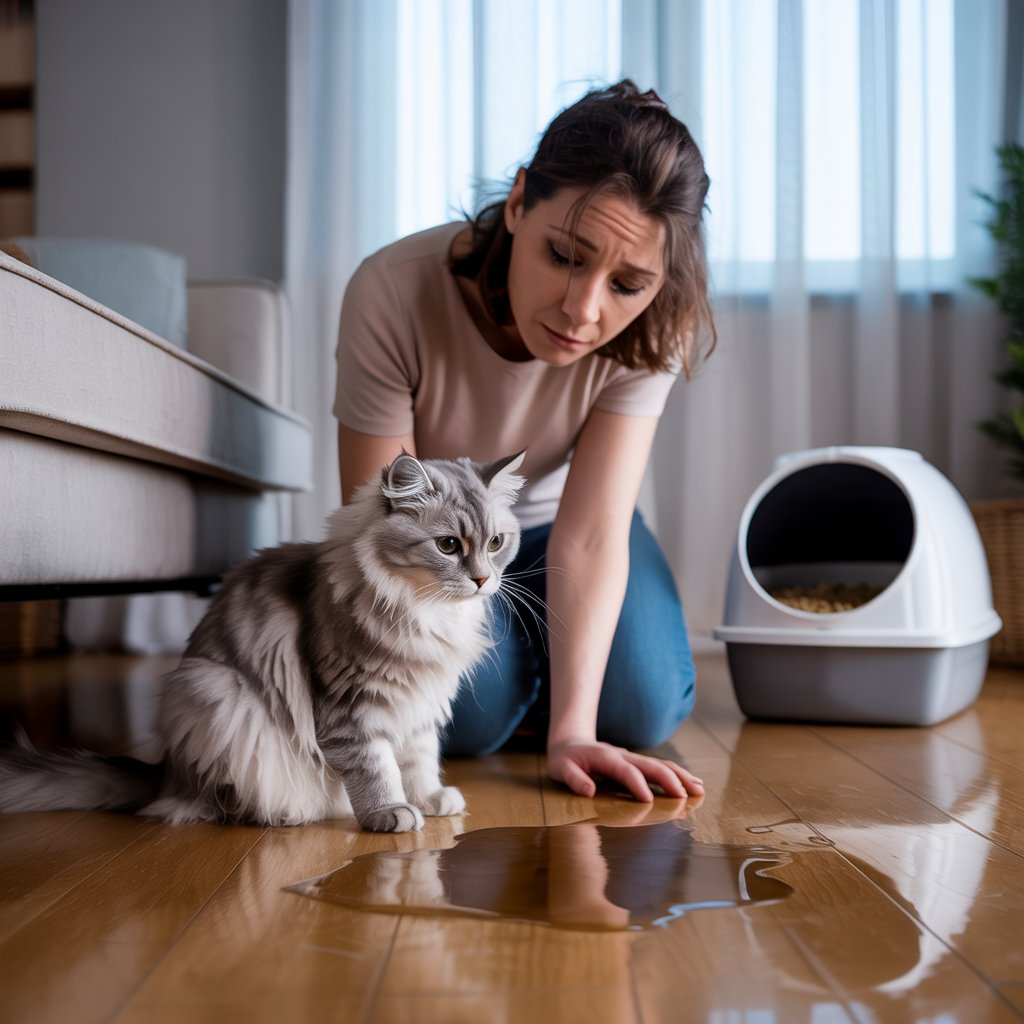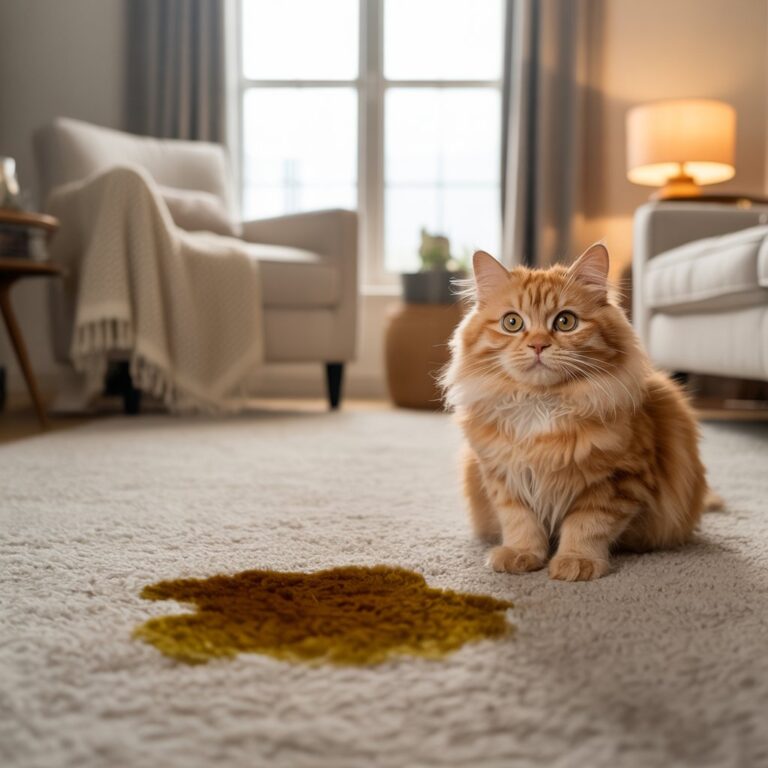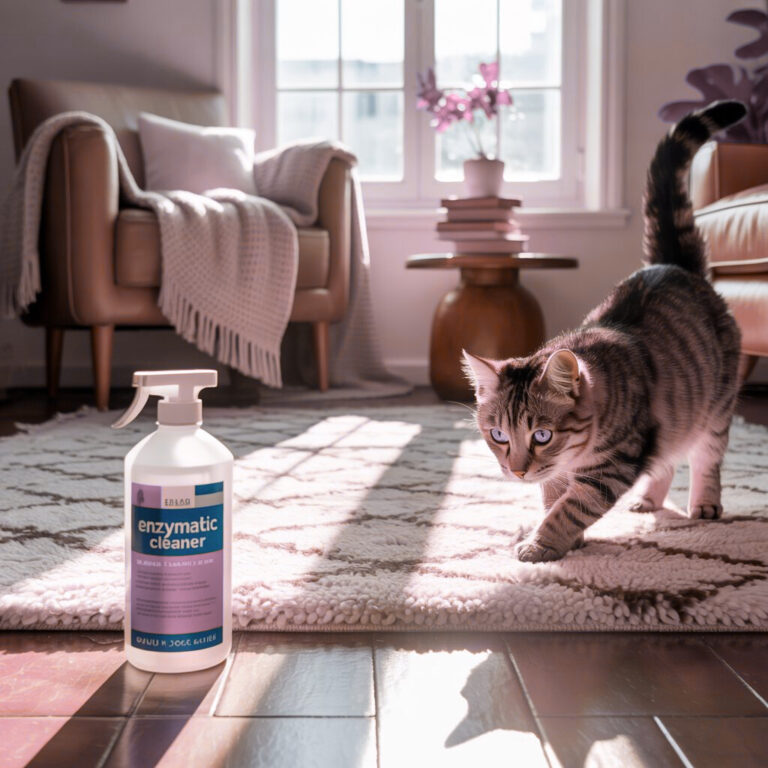How to Stop Cat Peeing Outside the Litter Box for Good
Is your cat peeing outside the litter box? It can feel like a personal betrayal. The carpet, the laundry pile, even right beside the box—nothing seems off limits. But before frustration turns into giving up, it’s important to understand that inappropriate urination isn’t spite. It’s communication. And usually, your cat is trying to tell you something important.
This guide breaks down the most common reasons cats avoid the litter box and offers real, practical steps to help restore harmony in your home.
- 1. Start With the Vet: Rule Out Medical Causes (Including Dehydration)
- 2. Litter Box Setup Mistakes (And How to Fix Them)
- 3. Is the Box in the Wrong Spot?
- 4. The Great Litter Debate
- 5. Stress, Territory, and Spraying
- 6. Multi-Cat Household Dynamics
- 7. Accidents Near the Box: Clues to Watch For
- 8. Cleaning Up Cat Pee the Right Way
- 9. Re-Training Your Cat
- 10. Special Considerations for Senior Cats
- 11. When It’s Behavioral, Not Medical
- Final Thoughts
- FAQ
1. Start With the Vet: Rule Out Medical Causes (Including Dehydration)
Before you start changing litters or moving boxes, make a vet appointment. Sudden changes in urination habits are often a sign of underlying medical issues.
Common health problems include:
- Urinary Tract Infections (UTIs): Painful and urgent, UTIs make cats associate the litter box with discomfort.
- Feline Idiopathic Cystitis (FIC): A bladder inflammation linked to stress and dehydration.
- Bladder/kidney stones: Sharp crystals or stones can make urination painful or impossible.
- Kidney disease: Leads to increased thirst and urination, and often accidents.
- Diabetes: Causes excessive thirst and frequent urination.
- Arthritis: Painful joints make it hard to climb into a box or squat to pee.
Don’t forget hydration. Dehydration is a major contributor to urinary problems. Cats fed mostly dry food often don’t drink enough water, leading to concentrated urine that irritates the bladder.
Boost your cat’s hydration by:
- Switching to wet food
- Adding water or low-sodium broth to meals
- Providing a pet fountain (cats love moving water)
- Keeping multiple water bowls clean and accessible
A full vet check-up can rule out or treat these issues—and it should always be your first step.
2. Litter Box Setup Mistakes (And How to Fix Them)
Cats can be surprisingly picky about where and how they eliminate. If the litter box isn’t meeting their standards, they may look for alternatives.
Checklist of common issues:
- Too few boxes: You need one per cat, plus one.
- Too small: Your cat should be able to comfortably turn around inside.
- Covered boxes: Some cats feel trapped or don’t like the smell buildup.
- Self-cleaning boxes: Great in theory, but noisy and unpredictable.
- Dirty boxes: Needs to be scooped daily and fully washed weekly.
- High sides: May be hard for kittens, seniors, or arthritic cats.
Try offering different styles of boxes to see what your cat prefers. Sometimes just changing the box shape or location makes all the difference.
3. Is the Box in the Wrong Spot?
Even the best litter box won’t work if it’s in the wrong place. Cats want quiet, private, and safe areas to do their business—not somewhere loud or hard to reach.
Avoid:
- High-traffic areas
- Close proximity to loud appliances (e.g., washing machines)
- Boxes next to food or water bowls
- Corners where other cats can ambush them
Do:
- Spread boxes out in different rooms
- Make sure at least one box is easily accessible at all times
- Put a box on every floor of a multi-story home
Placement matters just as much as the box itself.
4. The Great Litter Debate
Litter preference is real. Cats often have strong opinions about the texture, scent, and depth of the litter you provide.
Things to test and consider:
- Clumping vs. non-clumping
- Clay, paper, crystal, wood, or corn-based litter
- Scented vs. unscented (unscented is usually better)
- Depth of litter (most cats prefer about 2 inches)
If you change litter types: Do it gradually. Mix the new litter into the old over several days to avoid rejection.
You can even offer a “litter buffet”—multiple boxes with different litters—to let your cat choose.
5. Stress, Territory, and Spraying
When a cat sprays urine vertically on walls or furniture, it’s usually marking territory, not just urinating. Stress is often the trigger.
Common stressors:
- New people, pets, or babies in the home
- Seeing strange cats outside through windows
- Moving to a new home or rearranging furniture
- Boredom or lack of stimulation
Ways to reduce stress:
- Use pheromone diffusers like Feliway
- Provide vertical space (cat trees, shelves)
- Offer scratching posts and interactive toys
- Establish predictable routines
- Close blinds or block views of outside cats if needed
Spraying is a message. The key is to find out what your cat is trying to say.
6. Multi-Cat Household Dynamics
Litter box issues are common in homes with multiple cats. Even if everyone seems to get along, there could be tension you’re not seeing.
Look for:
- Box guarding: One cat blocks access to the litter box
- Subtle bullying: Staring, stalking, or ambushing at the box
- Resource stress: Too few boxes in convenient locations
Solutions:
- Increase the number of boxes and spread them out
- Use open boxes so cats can see if someone is approaching
- Watch for changes in social dynamics
- Ensure all cats feel safe accessing the box without conflict
7. Accidents Near the Box: Clues to Watch For
If your cat is peeing right beside the box, they may want to use it—but something’s wrong.
Possible reasons:
- The box is too dirty
- The litter hurts their paws
- The box is too small or hard to access
- There’s a strong lingering smell even after cleaning
Try placing a pee pad or second box where the accident happened to test if the location is the issue.
8. Cleaning Up Cat Pee the Right Way
Cats will return to places they’ve peed before if they can still smell it. Regular cleaners don’t eliminate the uric acid crystals in cat urine.
What you need:
- A bio-enzymatic cleaner specifically for pet urine
- Time: Some products require soaking and sitting for 10+ minutes
- Repeat cleaning if needed for older stains
Avoid using ammonia-based cleaners—they smell like urine to cats and may make things worse.
9. Re-Training Your Cat
If the habit is established, you may need to retrain your cat to use the box.
Steps:
- Confine the cat to a small room with a clean litter box, food, water, and bedding
- Praise and reward when they use the box
- Once consistent, gradually expand their access to the rest of the house
- Keep boxes clean and stress levels low throughout
Also try:
- Offering different boxes/litter types
- Moving the box to where accidents happen (then gradually to a better location)
Patience is key—it can take days or weeks, but most cats can be retrained.
10. Special Considerations for Senior Cats
Older cats may struggle with:
- Arthritis (making high-sided boxes painful)
- Cognitive decline (confusion or forgetting location)
- Increased urination from health conditions
Tips:
- Use low-sided or open-front boxes
- Keep boxes in familiar, easy-to-reach places
- Visit the vet regularly to catch age-related issues early
11. When It’s Behavioral, Not Medical
If your vet gives the all-clear, the issue is likely environmental or behavioral.
What to do:
- Journal the accidents: location, time, what was happening around them
- Look for patterns (noise, new people, after playtime, etc.)
- Consider consulting a feline behaviorist for chronic cases
Behavioral issues aren’t always quick fixes, but they are solvable with the right approach.
Final Thoughts
Dealing with a cat peeing outside the litter box is frustrating, but it doesn’t mean your cat is “bad” or that you’re doing something wrong. Cats are sensitive creatures, and when something disrupts their sense of safety or comfort, they let us know—with pee.
By approaching the problem with curiosity and compassion, most litter box issues can be solved. Start with a vet check, then look at your litter box setup, stress, and cleanliness. Stay patient. And remember: your cat isn’t trying to ruin your home. They’re just asking for help the only way they know how.
FAQ
Why is my cat peeing on soft things like beds and laundry?
Soft surfaces may feel comforting to cats under stress. They also absorb urine well and may smell more like you.
My cat still poops in the litter box but pees elsewhere. Why?
A cat peeing outside the box is more often related to stress or medical issues, while pooping tends to be a more deliberate action. Different muscles, different triggers.
Can I punish my cat for peeing on the floor?
No. Punishment damages trust and won’t solve the root issue. It may even increase anxiety and make things worse.
Can an older cat suddenly develop litter box issues?
Yes. Arthritis, dementia, vision loss, or health changes can cause even a well-trained cat to have accidents.
Do cats pee outside the box out of spite?
No. It might feel that way, but cats don’t act out of revenge. They act out of discomfort, fear, or stress.
Need more help? Stay tuned for our free printable checklist and litter box troubleshooting chart, coming soon!



